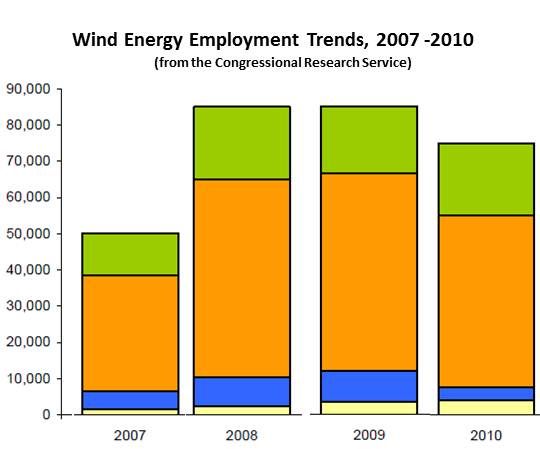While two economic bubbles burst between 2000 and 2010, the renewable energy sector -- led by wind and solar -- emerged as serious players in the energy sector. The U.S. solar energy industry generated $6 billion last year and now employs 100,000 people. As of July 2011, the U.S. wind energy industry provided three percent of U.S. power and 75,000 jobs.
To reach this level of achievement, renewables leaders had to turn potential into practical solar- and wind-energy-generating technologies. They had to re-educate the public, utility and transmission system operators, and the power brokers in Washington and state capitals. And they had to do these things while building supply chains, workforces, public relations presences and advocacy organizations.
Throughout this period of emergence, wind -- the most mature of the technologies -- led. Its very success, though, has brought the wind industry face-to-face with its greatest challenge.

Wind now finds itself fighting “lots of people with money and organization,” said greentech public relations specialist Mike Casey of Tigercomm at the American Wind Energy Association (AWEA) Fall Symposium. Opponents of wind have seen the sector grow to 35 percent of new U.S. electricity generation in the last five years, while coal’s share of power fell from 48 percent to 44 percent -- and they are now intent on reversing that trend.
Opponents generate propaganda on behalf of the fossil fuels and nuclear industries with the issues of “redundancy and reach,” Casey noted. It transformed the idea of putting a price on greenhouse emissions from inevitable to unforeseeable in less than two years between 2008 and 2010 (admittedly assisted by a disastrous economic environment). It changed the portion of U.S. voters concerned about global climate change, according to recent polls, from over a half to little more than a third.
And now it has set its sights on taking back wind’s share of new power production.
As reported by Greentech Media, misinformation about wind is proliferating, propagated by a small army of well-paid think-tank and university pontificators and a media that thrives on naysayers and nonsense.
Finding their way more often into the media recently are several myths about utility-scale wind. The claim that reliance on it actually increases greenhouse gas emissions, which doesn’t even pass the smell test, is absolutely false except in the tiniest, most limited and irrelevant circumstances. The claim that it drives up ratepayers’ power prices is also false; where there are large penetrations of wind in a transmission system, the marginal cost of power often falls to zero or below.
Claims of harms to birds overlook, first, the statistical fact that of every 10,000 bird deaths from human-created infrastructure, approximately one is from wind turbines. This claim also overlooks the fact that the newest generation of wind farms will reduce that number.
The wind industry has decided enough is enough.
“Silence is taken as ‘pour it on,’” political consultant Matt Leonardo of Revolution Agency told the wind professionals gathered at the AWEA symposium. “If you don’t respond to what people say, it becomes true.”
“People want to hear from the wind industry,” added pollster Alex Bratty of Public Opinion Strategies, “about how it can improve energy security and reduce dependence on foreign oil.”
Bratty elaborated on wind’s strong showing in polls; Leonardo will soon introduce saveUSAwindJobs.com, a new campaign to convince Congress to renew wind’s vital Production Tax Credit (PTC); and Casey outlined a five-point program to neutralize the onslaught of wind’s enemies.

The 2.3 cents per kilowatt-hour PTC has often been a political football since its 1992 inception. Designed to spur investment by cash-rich private sector financial entities seeking tax relief, conservatives have attempted to characterize it as “the government picking winners,” despite the fact that most renewables qualify for it. When the PTC has been withheld, as Congress is presently threatening to do despite the public’s strong support of renewables, development has dropped off drastically.
“More than eight in 10 Americans say we should be relying on wind,” Bratty said, because “it’s something we can produce here.” And, she added, “it creates jobs and grows the economy.” There is even more support for wind, Bratty said, among young people and women.
Claims that wind technology is not competitive because it requires a tax credit, which attackers usually disdainfully refer to as a subsidy, she said, are misguided. “The PTC leverages private financing. Why would people be putting money in it if it wasn’t working?”
“Right now, the PTC does not have enough support to pass the House,” Leonardo said. “Thirty to 40 people representing districts around the country will decide its fate.” The goal, he said, is to change public opinion. “Politicians will follow public opinion when the time comes to vote.”
“Ineffective, expensive and unreliable,” Casey said, are the words wind’s opponents use. The underlying message is that wind is “illegitimate,” he explained.
Casey urged the industry’s leaders to take five steps: 1) Educate the local media; 2) Write and place opinion pieces outlining the good wind does; 3) Organize outreach to communities and their elected leaders; 4) Showcase wind industry personalities and their inspiring stories; and 5) Use social media, especially LinkedIn and Facebook, to do all of the above.
“How we buy electricity is a political decision,” inside-the-beltway strategist Leonardo said. “The fossil fuel industries see wind as a threat because costs are coming down.” But, he added, “wind has a wonderful story to tell.”



